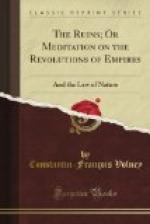THE RUINS OF EMPIRES.
CHAPTER I.
The journey.
In the eleventh year of the reign of Abd-ul-Hamid, son of Ahmid, emperor of the Turks; when the Nogais-Tartars were driven from the Crimea, and a Mussulman prince of the blood of Gengis-Kahn became the vassal and guard of a Christian woman and queen,* I was travelling in the Ottoman dominions, and through those provinces which were anciently the kingdoms of Egypt and Syria.
* In the eleventh year of Abd-ul-Hamid, that is 1784 of the Christian era, and 1198 of the Hegira. The emigration of the Tartars took place in March, immediately on the manifesto of the empress, declaring the Crimea to be incorporated with Russia. The Mussulman prince of the blood of Gengis-khan was Chahin-Guerai. Gengis-Khan was borne and served by the kings whom he conquered: Chahin, on the contrary, after selling his country for a pension of eighty thousand roubles, accepted the commission of captain of guards to Catherine ii. He afterwards returned home, and according to custom was strangled by the Turks.
My whole attention bent on whatever concerns the happiness of man in a social state, I visited cities, and studied the manners of their inhabitants; entered palaces, and observed the conduct of those who govern; wandered over fields, and examined the condition of those who cultivated them: and nowhere perceiving aught but robbery and devastation, tyranny and wretchedness, my heart was oppressed with sorrow and indignation.
I saw daily on my road fields abandoned, villages deserted, and cities in ruin. Often I met with ancient monuments, wrecks of temples, palaces and fortresses, columns, aqueducts and tombs. This spectacle led me to meditate on times past, and filled my mind with contemplations the most serious and profound.
Arrived at the city of Hems, on the border of the Orontes, and being in the neighborhood of Palmyra of the desert, I resolved to visit its celebrated ruins. After three days journeying through arid deserts, having traversed the Valley of Caves and Sepulchres, on issuing into the plain, I was suddenly struck with a scene of the most stupendous ruins—a countless multitude of superb columns, stretching in avenues beyond the reach of sight. Among them were magnificent edifices, some entire, others in ruins; the earth every where strewed with fragments of cornices, capitals, shafts, entablatures, pilasters, all of white marble, and of the most exquisite workmanship. After a walk of three-quarters of an hour along these ruins, I entered the enclosure of a vast edifice, formerly a temple dedicated to the Sun; and accepting the hospitality of some poor Arabian peasants, who had built their hovels on the area of the temple, I determined to devote some days to contemplate at leisure the beauty of these stupendous ruins.




